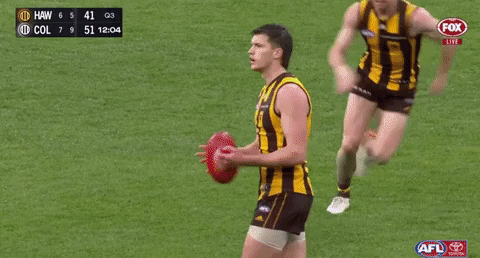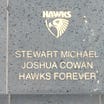Subscribe to Hawks Insiders for the most in-depth and wide ranging Hawthorn cover there is. From exclusive interviews to analysis, match recaps to podcasts, the Insiders have you covered.
Aside from being newly drafted to an AFL club in the same draft, you may wonder which personal feature do Noah Mraz (as a tall key defender) and Codey Anderson (as a tough inside midfielder) share?
In his book title Outliers, Malcolm Gladwell investigated some traits that may explain why some people were to become successful in their chosen career. The book gained some notoriety at the time for the assessment of the need to have at least 10,000 hours of practice to master a skill.
Another trait that Gladwell addressed was identified by a psychologist watching a Canadian ice hockey representative game from the program for the match - the dates of birth of the players.
With the age qualification from the team determined by players date of birth as 1 January of that year, the players picked for this representative team were predominantly born in the January to March months of that year.
This led to Gladwell and others to postulate that players born earlier in the year of their age group provided them with a “natural” advantage as their physical development, given usual progression, was more advanced than those who were born later in the year.
This in turn then meant that these players were more likely to be selected for academies and pathways as they progressed through the system, giving them access to more specialist coaching that further enhanced their progression compared to those who missed selection in these squads due to their birthdate.
The Hawthorn connection?
How does this relate to our draftees? Anderson was born on 30 January and Mraz on 20 February.
Anderson being described as the ‘Beast from the East’ may have as much to do that he could be playing against competitors who were 10 and possibly 11 months younger than him through his junior career.
As for Mraz, he played in the U/18 National Championships in his bottom age year when he may have been only two months younger than a player in the final U/18 year. For example, Mraz would have been two months younger than Jack Ginnivan in his draft year.
There may well be a bottom age year in the Coates Talent League where players may have at least two years, however in their draft year there may be an “early” final year factor that should be noted more widely.
As of 1 January 2025, both Mraz and Anderson are 18-year-olds, but come the first game they will be 19 year olds - both are a year older, but still not played a game and this is where average ages can be deceptive.
(Note: For the first round picks this year, 41% were born in the January - April period compared to 15% for the September - December period with only one born in December – Levi Ashcroft (18/12/2006). This means he was two weeks from being in next year’s draft and as with any outlier discussions, there are always exceptions to the rule.)
(* Leaving Gunston aside as a recent draftee!!)
How does this concept apply to our current list?
Looking purely at the date of births, 29% (12 players) of the list were born in January-February with 45% of the list born before July. August is the most popular birth month for the list with seven players celebrating their birthdays, which is only one less than those who were born in October to December.
At a first glance, the concept may not be as applicable to our list as Gladwell’s theory may have hoped, but I’d suggest that this is where we need to delve a little deeper as to how each player may have entered the AFL system. With the AFL draft system having a “few” compromises e.g. father-son, academies, compensation picks and secondary avenues (eg rookie and expansion drafts), the argument may still hold relevance.
For example, in the case of any father-son selections, the commitment to the family connection to the club may well override any concerns with the birth month, although this is probably an untestable theory as clubs may not elect to nominate a potential father-son for this reason. The same may well apply to NGA selections, although clubs appear to be more prepared to let these players slip through at times.
When you look at the players by their month of birth and original source of selection into the system, for January - February there is only one player who was originally a rookie selection – Mabior Chol. From our own picks, you can see that a core part of the current and future team comes from these months. The very early comparison between Anderson (30/1) and James Worpel (24/1) may have as much to do with how close their birthdays are than anything else.
Extending out to the January - June period, of the 19 players, there is one Category B selection, another imported rookie (Massimo D’Ambrosio), a Category B selection (Changkouth Jiath) and a rookie selection (Max Ramsden). While Will Day and Josh Weddle were added as key picks contributing to the next generation.
Looking at the July - December birth months, I’d suggest that the theory may have greater applicability, in that of the 23 players, nine were rookie selections along with another father-son (Calsher Dear) and Category B selection (Conor Nash). With the rookie selections it may confirm that the club is prepared to be more speculative in making these picks with development being genuinely taking into consideration over the age and maturity of the player.
Along with these picks there were two other genuinely speculative picks in the 2016 draft with our first two picks – Harry Morrison (Pick 74) and Mitch Lewis (Pick 76) – being similarly speculative and have proved to be more than handy, given the circumstances.
Furthermore, another six players of this group were traded into the club – Jack Gunston, Jarman Impey, Jack Scrimshaw, Karl Amon, Josh Battle, Tom Barrass – so they were known products at the time rather than assessing their potential based solely on their draft years.
Validating the concept
Within this group, there are a few examples that may “validate” this concept:
1. Luke Breust, as a rookie, played games in Box Hill seconds early in his career and weighed less than 70kgs.
2. Jai Newcombe – having not been part of the AFL pathway, being identified and taken in the mid-season draft the club was able to get in early before he would have been part of a full national draft.
3. Dylan Moore – even having been originally drafted, his progression or lack thereof then meant he was delisted and rookied could have been as much to do with his relative physical development at that time of his career like Breust’s pathway.
Unlike horse racing where there is a strong degree of science as to the breeding of horses and their potential success, for AFL players and recruiters, it is as much an art as a science in determining whether a player will make the grade.
This then leads to potential argument between recruiters and coaches, but more commonly between supporters: ‘We drafted you the best players in the land, why didn’t you develop them?’ Or the reverse: ‘what did you guys see in this player when you drafted them?’
A similar line of argument also occurs between horse owners and trainers by the way!
Make sure to follow us on social media through the links below:










Once again Mick you've come up with another interesting way to dissect our playing group ... what a fascinating concept to consider. I know you've explained your teaching background to me before, but what I would like to know is how and when do these ideas come into your head? And once they are there, are you the type to stop what you are doing and put down your thoughts straight away? No matter how it happens, I for one, are very appreciative that you share with all that follow the Hawks Insiders so I look forward to what comes next ... Go Hawks!!
Not sure where this landed but is the hypothesis there is value to be found in later birth mths as they are less likely to stand out and be higher rated early doors but by the time they are 20 then it has evened out?